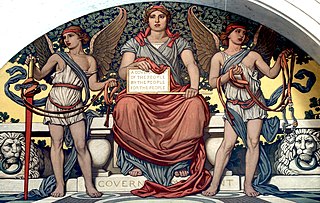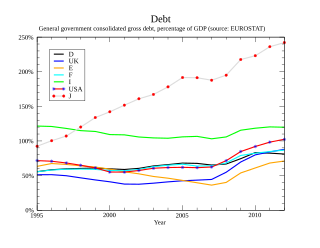Related Research Articles

The International Monetary Fund (IMF) is a major financial agency of the United Nations, and an international financial institution funded by 191 member countries, with headquarters in Washington, D.C. It is regarded as the global lender of last resort to national governments, and a leading supporter of exchange-rate stability. Its stated mission is "working to foster global monetary cooperation, secure financial stability, facilitate international trade, promote high employment and sustainable economic growth, and reduce poverty around the world."

Currency substitution is the use of a foreign currency in parallel to or instead of a domestic currency.

The global financial system is the worldwide framework of legal agreements, institutions, and both formal and informal economic action that together facilitate international flows of financial capital for purposes of investment and trade financing. Since emerging in the late 19th century during the first modern wave of economic globalization, its evolution is marked by the establishment of central banks, multilateral treaties, and intergovernmental organizations aimed at improving the transparency, regulation, and effectiveness of international markets. In the late 1800s, world migration and communication technology facilitated unprecedented growth in international trade and investment. At the onset of World War I, trade contracted as foreign exchange markets became paralyzed by money market illiquidity. Countries sought to defend against external shocks with protectionist policies and trade virtually halted by 1933, worsening the effects of the global Great Depression until a series of reciprocal trade agreements slowly reduced tariffs worldwide. Efforts to revamp the international monetary system after World War II improved exchange rate stability, fostering record growth in global finance.

In public finance, a lender of last resort (LOLR) is the institution in a financial system that acts as the provider of liquidity to a financial institution which finds itself unable to obtain sufficient liquidity in the interbank lending market when other facilities or such sources have been exhausted. It is, in effect, a government guarantee to provide liquidity to financial institutions. Since the beginning of the 20th century, most central banks have been providers of lender of last resort facilities, and their functions usually also include ensuring liquidity in the financial market in general.
Foreign exchange reserves are cash and other reserve assets such as gold and silver held by a central bank or other monetary authority that are primarily available to balance payments of the country, influence the foreign exchange rate of its currency, and to maintain confidence in financial markets. Reserves are held in one or more reserve currencies, nowadays mostly the United States dollar and to a lesser extent the euro.
Structural adjustment programs (SAPs) consist of loans provided by the International Monetary Fund (IMF) and the World Bank (WB) to countries that experience economic crises. Their stated purpose is to adjust the country's economic structure, improve international competitiveness, and restore its balance of payments.
The Convertibility plan was a plan by the Argentine Currency Board that pegged the Argentine peso to the U.S. dollar between 1991 and 2002 in an attempt to eliminate hyperinflation and stimulate economic growth. While it initially met with considerable success, the board's actions ultimately failed. The peso was only pegged to the dollar until 2002.

The Latin American debt crisis was a financial crisis that originated in the early 1980s, often known as La Década Perdida, when Latin American countries reached a point where their foreign debt exceeded their earning power, and they could not repay it.
A financial crisis is any of a broad variety of situations in which some financial assets suddenly lose a large part of their nominal value. In the 19th and early 20th centuries, many financial crises were associated with banking panics, and many recessions coincided with these panics. Other situations that are often called financial crises include stock market crashes and the bursting of other financial bubbles, currency crises, and sovereign defaults. Financial crises directly result in a loss of paper wealth but do not necessarily result in significant changes in the real economy.
In finance, an asset–liability mismatch occurs when the financial terms of an institution's assets and liabilities do not correspond. Several types of mismatches are possible. An asset-liability mismatch presents a material risk at institutions with significant debt exposure, such as banks or sovereign governments. A significant mismatch may lead to insolvency or illiquidity, which can cause financial failure. Such risks were among the principal causes of economic crises such as the 1980s Latin American Debt Crisis, the 2007 Subprime Mortgage Crisis, the U.S. Savings and Loan Crisis, and the collapse of Silicon Valley Bank in 2023.
In financial economics, a liquidity crisis is an acute shortage of liquidity. Liquidity may refer to market liquidity, funding liquidity, or accounting liquidity. Additionally, some economists define a market to be liquid if it can absorb "liquidity trades" without large changes in price. This shortage of liquidity could reflect a fall in asset prices below their long run fundamental price, deterioration in external financing conditions, reduction in the number of market participants, or simply difficulty in trading assets.

The Great Recession was a period of market decline in economies around the world that occurred from late 2007 to mid-2009. The scale and timing of the recession varied from country to country. At the time, the International Monetary Fund (IMF) concluded that it was the most severe economic and financial meltdown since the Great Depression.
Macroprudential regulation is the approach to financial regulation that aims to mitigate risk to the financial system as a whole. After the 2007–2008 financial crisis, there has been a growing consensus among policymakers and economic researchers about the need to re-orient the regulatory framework towards a macroprudential perspective.
Domestic liability dollarization (DLD) refers to the denomination of banking system deposits and lending in a currency other than that of the country in which they are held. DLD does not refer exclusively to denomination in US dollars, as DLD encompasses accounts denominated in internationally traded "hard" currencies such as the British pound sterling, the Swiss franc, the Japanese yen, and the Euro.
Monetary policy in the United States is associated with interest rates and availability of credit.

Debt crisis is a situation in which a government loses the ability of paying back its governmental debt. When the expenditures of a government are more than its tax revenues for a prolonged period, the government may enter into a debt crisis. Various forms of governments finance their expenditures primarily by raising money through taxation. When tax revenues are insufficient, the government can make up the difference by issuing debt.

Adam Lerrick is an American economist and politician who served as Counselor to the Secretary of the Treasury, and was previously Donald Trump's nominee for Assistant Secretary of the Treasury for International Finance. Lerrick is also an economist at the American Enterprise Institute.
Enrica Detragiache is the head of the Germany Desk of the International Monetary Fund (IMF), and the assistant director of the IMF's European division. She formerly taught Economics at Johns Hopkins University, and has published over 70 research papers and articles. Her research covers topics such as labour migration, financial crises, development economics, and corporate finance.
The Intervention of ECB in the Eurozone Crisis were the interventions made between 2009 and 2010 by the European Central Bank (ECB) during the European debt crisis. In 2009–2010, due to substantial public and private sector debt, and "the intimate sovereign-bank linkages" the eurozone crisis impacted the periphery countries in Europe. This resulted in significant financial sector instability in Europe; banks' solvency risks grew, which had direct implications for their funding liquidity.
References
- Bagehot, Walter. 1873. Lombard Street: A Description of the Money Market . London: William Clowes and Sons.
- Calomiris, Charles. 2003. "Blueprints for a New Global Financial Architecture." In: Leonardo Auernheimer, editor. International Financial Markets: The Challenge of Globalization. Chicago, United States: University of Chicago Press.
- Eichengreen, Barry. 1999. Toward a New International Financial Architecture: A Practical Post-Asia Agenda . Washington, DC, United States: Institute for International Economics.
- Fernández-Arias, E. 2010. "International Lending of Last Resort and Sovereign Debt Restructuring." In: C. Primo and G. Vincellete, editors. Sovereign Debt and the Financial Crisis: Will This Time Be Different? Washington, DC, United States: World Bank.
- Fernández-Arias, Eduardo and Eduardo Levy Yeyati. 2010. "Global Financial Safety Nets: Where Do We Go from Here?" IDB-WP-231. Washington, DC, United States: Inter-American Development Bank.
- Sachs, J.D. 1995. "The International Lender of Last Resort: What Are the Alternatives?"